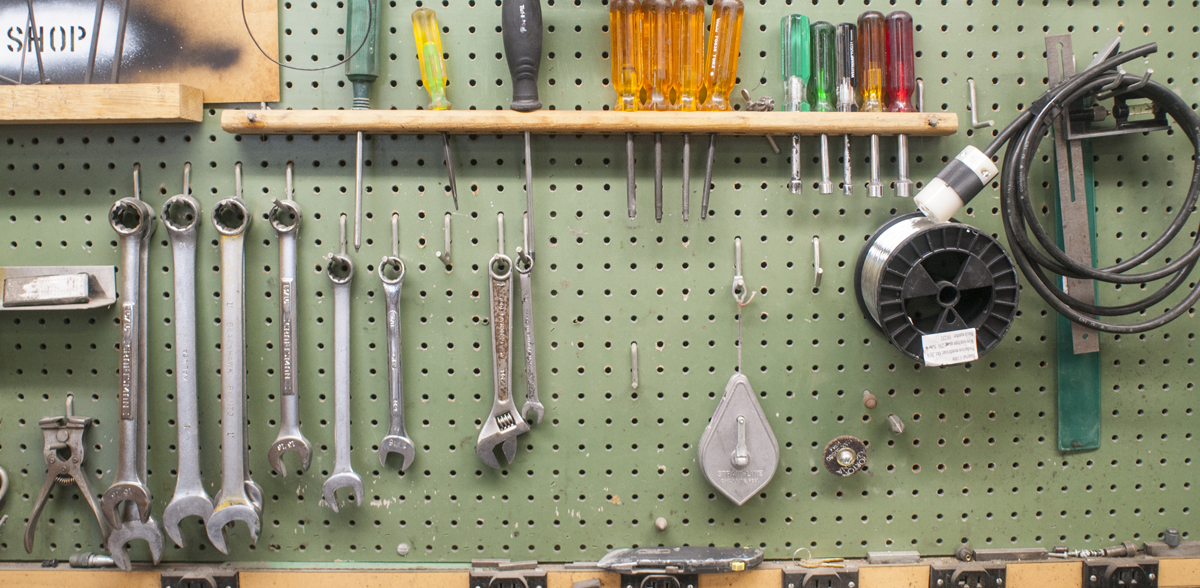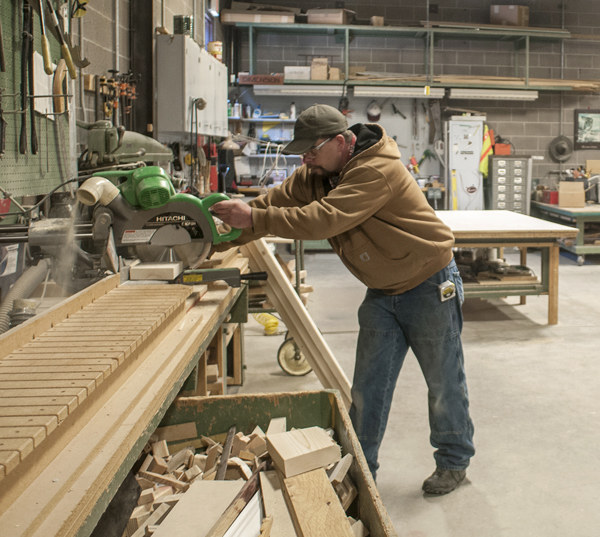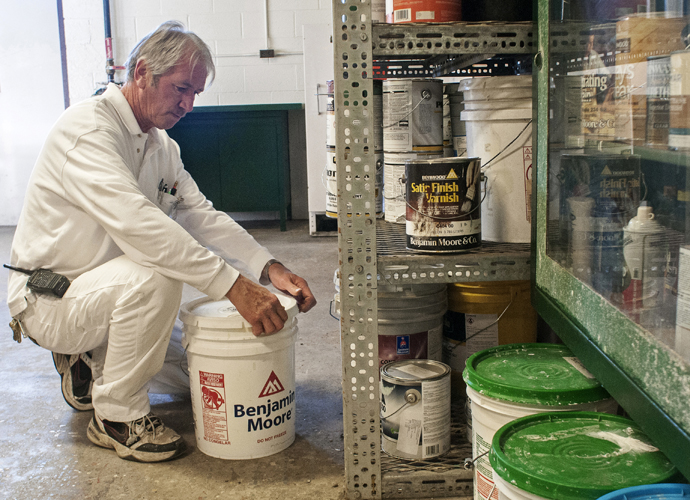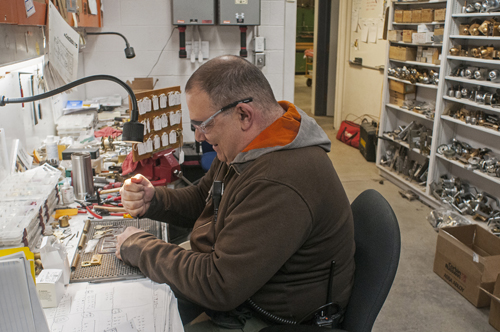- Editorial Offices
- 203 Brantly Hall
- Missoula, MT 59812
- (406) 243-2488
- themontanan@umontana.edu
Journeymen
Facilities crew maintains UM's hertiage through trades.
Among the diverse walks of life that find their way to UM, the greatest common denominator between them are the doorways, classrooms, lawns, equipment and spaces that house the greater UM family.
For as many years as some UM students are old, a group of employees in UM Facilities Services has dedicated their professional careers to fixing, building, tinkering, adjusting, painting and maintaining the lifeblood of UM.
The result of their collective impact is a fully functional and safe University, one that blends old and new architecture and manicured grounds to make for one of the most stunning and recognizable campuses in the West.
In a modern economy desperate for the benefits of skilled labor, UM’s Facilities Services has that talent in spades.
When students lean back in a mission-style wooden chair or take their notes on a curved desk in Jeannette Rankin Hall, they may not realize both were crafted by a UM staff carpenter. Main Hall’s doors – hung in 1898 – are still swinging 121 years later, thanks to decades of delicate protection.
No matter how low the mercury drops in winter, the walks are shoveled and the radiators hiss. Crown molding on stately bookshelves, digital key locks, grand staircase guardrails, creaking wood floors and 19th-century hardware come together to reflect the subtle details of an authentic UM experience.
“Some of these guys have been here as long as some of the buildings,” says Kevin Krebsbach, director of UM Facilities. “That’s about the time it takes to appreciate the nuances of each building, of the hidden corners of campus and how it all comes together.”
Krebsbach has been on campus for 30 years. For 26 of those years, he served as the head UM Planning and Construction, before directing more than 100 employees as Director of UM Facilities, which includes everything from “high performance building, steam turbines and pigeon mitigation,” he says.
In that time there’s not a day that’s been the same, because “things break, the weather changes and priorities change,” Krebsbach says. “We have to be able to respond to all of it and in a timely way. It doesn’t matter if it’s a holiday or weekend. We all work together to address issues.”
Working long hours to bolster and protect UM’s physical presence is part and parcel of the job. Anytime UM hosts a concert, beautifies campus for Commencement ceremonies or plans to retrofit a building for new infrastructure, UM Facilities has spent months planning. The same is true for the late-night phone calls or emergency repairs of equipment running on borrowed time.
While a good portion of the staff has “joined the silver hair group” Krebsbach says, it used to be easier for the University to recruit talent from Missoula area mills, especially when it comes to those with a penchant to understand and operate UM’s famous boiler system and underground steam tunnels.
“It’s getting really hard to find people with those skills,” he says. “We have to get creative with the way we recruit and think about apprenticeships. Most of us are nearing the end of our careers.”
After a career spent overseeing a campus integrating varying LEED-certified buildings, keeping pace with technological changes and maintaining UM’s physical presence, Krebsbach speaks for all facilities staff when he says, “Solving problems for campus that benefits students and staff gives me great pride.”
MEET A FEW OF UM’S DEDICATED TRADESMEN:
Carpenter: Eddie Tomicek
Eddie Tomicek likes to say he’s been “going to college every day for the past 20 years.” He left Pittsburg and joined UM in 1996, for a temporary summer carpentry position that morphed into a fine woodworking career for the University. The great-grandson of an Austrian immigrant and master carpenter, Tomicek is a third-generation carpenter. His father, Ed, worked for 15 years as a UM carpenter before retiring a few years ago. Tomicek works near his father’s old bench in the campus shop.
Tomicek likes working in buildings “with the more wood, the better,” and says his carpentry career at UM has kept his skills sharp “because there’s something different every day.”
 His fine wood working skills have led to projects that enhance the University and added to its legacy and charm.
His fine wood working skills have led to projects that enhance the University and added to its legacy and charm.
Some of his favorite projects include building the flag holders in front of the Payne Family Native American Center, working with the beetle-kill blue-stained wood in the Forestry Building and working with steam to bend the maple chair rails in the Music Building.
“I really like working in the old buildings,” Tomicek says. “I can’t help but think about the guy before me who put this stuff in.”
Much of the repairs in UM’s oldest buildings has to be handmade “because you can’t buy the parts to replace some of that stuff,” he says. That includes learning the delicate maneuvers to maintain Main Hall’s double-hung windows, operated by sashes in the frames.
“There’s an app for everything, but there’s no app for fine woodworking,” he says. “I think when people remember their collegiate experience even 20 years from now, they think of the sense of place ̶ everything from the carpet to the curtains. That’s our domain.”
Painter: Bill Hemphill
After 28 years on the job as UM’s painting foreman, William Hemphill still likes the smell of fresh paint. Painting and manicuring UM walls, offices and parking lots for most of that time, Hemphill says successfully working under three presidents has been dependent on one thing: trust.

For Hemphill, painting UM transcends more than the 17 different shades of maroon, all organized in his shop according to building. He calls every job “a different chapter.”
“The University’s curb appeal has to make a good first impression,” he says. “That translates directly to enrollment, because we’re making a concerted effort to welcome students and their families.”
“Nomadic desert,” a soft sand color, is Hemphill’s favorite. He saves each color match for every building on campus. For the occasional times that graffiti has vandalized UM, Hemphill takes the offense personally.
“What people don’t realize is that they spend four minutes vandalizing UM, and it takes us six hours to fix it,” he says. “It’s an offense to all of us who spend our days caring for this place.”
The best part of the job, Hemphill says, is the satisfaction he gets from transforming the space, along with the people who inhabit it.
“I get a lot of self-satisfaction and pride from seeing what I’ve accomplished and then seeing the occupant happy,” he says. “A coat of paint will do wonders. Nobody wants to spend time in a drab environment.”
Locksmith: Alex Fradkin
 Alex Fradkin came to know locks by magic. A Brooklyn native who spent his younger years entertaining patrons at his cousin’s restaurant, Fradkin has always loved Harry Houdini. Refining his talent for illusion and tricks, Fradkin realized Houdini was a locksmith by trade.
Alex Fradkin came to know locks by magic. A Brooklyn native who spent his younger years entertaining patrons at his cousin’s restaurant, Fradkin has always loved Harry Houdini. Refining his talent for illusion and tricks, Fradkin realized Houdini was a locksmith by trade.
So he enrolled in locksmith training, too, because “locks are more lucrative than magic,” he says.
Shortly thereafter, Fradkin followed a friend he had hiked the Appalachian Trail with to Missoula. Fradkin quickly fell for the Rocky Mountains and enrolled as a creative writing major in 1988.
Since 1997, he’s been at UM with a big key chain on his belt.
As the UM Locksmith, Fradkin knows every lock on campus from the 90-year-old lock on the Forestry Building to the newer, electronic entries on the Gilkey Building.
“We’ve gone electronic on many of our locks, and there’s a learning curve when we get the new stuff,” Fradkin says. “But when it comes to safety, the new additions always positively benefit the campus.”
For the stubborn locks, Fradkin is able to retrofit a fix at his shop on campus, where he modifies a certain part or crafts a new one.
The best part of the job for Fradkin is the people he works with, in a position that “keeps security at the highest level for the safety of everyone at UM,” he says.
Another highlight as UM’s locksmith is enjoying the look on people’s faces after Fradkin grants them reentry into their car or office after being locked out.
“It’s always gratifying to help people who are desperate, especially if it’s raining,” he says.




